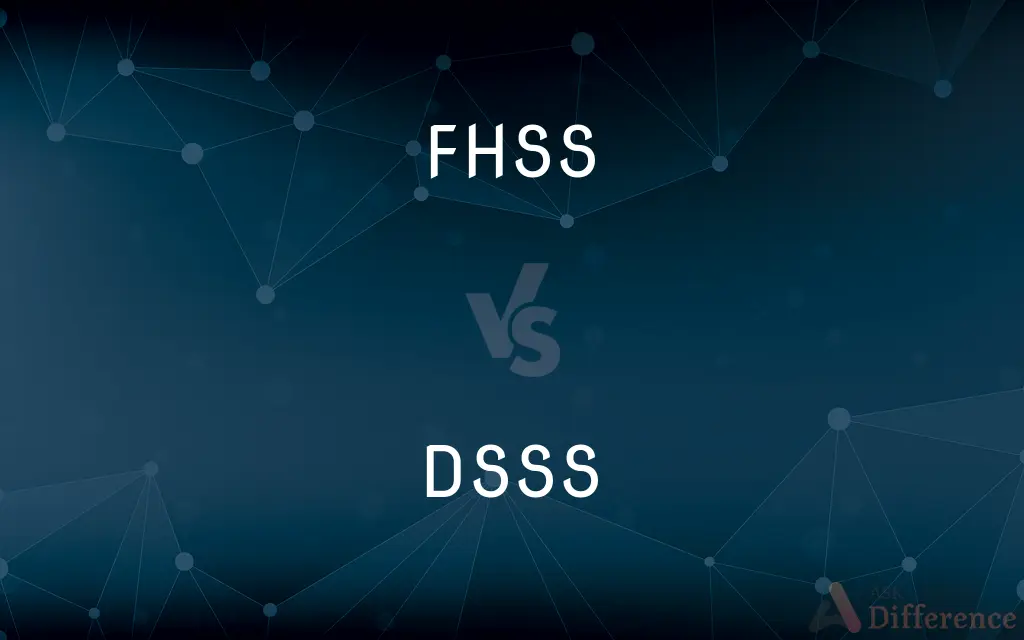FHSS vs. DSSS — What's the Difference?
By Tayyaba Rehman — Published on January 24, 2024
FHSS (Frequency Hopping Spread Spectrum) changes frequencies in a pattern known to both transmitter and receiver, while DSSS (Direct Sequence Spread Spectrum) spreads the signal over a wider frequency band using a specific code.

Difference Between FHSS and DSSS
Table of Contents
ADVERTISEMENT
Key Differences
Frequency Utilization: FHSS quickly switches between different frequencies within a given band, making it resilient to interference and eavesdropping. DSSS, on the other hand, uses a single frequency band at a time but spreads the signal over a wider range to reduce the risk of interference.
Signal Security and Interference: FHSS offers enhanced security due to its changing frequencies, making it difficult to intercept or jam. DSSS is less secure from an interception standpoint but is better at handling interference, as the spreading code helps in distinguishing the signal from noise.
Complexity and Cost: FHSS systems are generally simpler and less expensive than DSSS systems. DSSS requires more complex processing to apply and recover the spreading code, increasing the cost and complexity of the system.
Data Transmission Rate: FHSS typically has lower data transmission rates due to the time spent in switching frequencies. DSSS can achieve higher data rates as it continuously uses the entire band.
Application Usage: FHSS is commonly used in tactical military communications and Bluetooth technology, where security and resistance to jamming are crucial. DSSS is used in Wi-Fi networks (802.11b, for example) for its ability to handle high data rates and its robustness against interference.
ADVERTISEMENT
Comparison Chart
Frequency Utilization
Switches between different frequencies
Spreads the signal over a wider frequency band
Security and Interference
High security, resistant to interference
Less secure, robust against interference
Complexity and Cost
Less complex, cost-effective
More complex, generally costlier
Data Transmission Rate
Typically lower
Higher due to continuous use of the band
Typical Applications
Military communications, Bluetooth
Wi-Fi networks (e.g., 802.11b)
Compare with Definitions
FHSS
The security aspect of FHSS technology.
FHSS security is beneficial in military communication.
DSSS
A network that utilizes DSSS technology.
Our office Wi-Fi uses a DSSS network for efficient data transmission.
FHSS
A system that implements FHSS technology.
The FHSS system in our devices ensures secure data transfer.
DSSS
The type of signal used in DSSS technology.
The DSSS signal is robust against external noise and interference.
FHSS
A spread spectrum technique using rapid frequency switching.
FHSS is employed in Bluetooth to enhance security.
DSSS
A spread spectrum technique that spreads the signal across a wide frequency band.
DSSS is commonly used in Wi-Fi technology.
FHSS
The process of changing frequencies in FHSS.
Frequency hopping in FHSS makes it hard to intercept.
DSSS
The method of spreading the signal in DSSS.
The direct sequence in DSSS helps in reducing interference.
FHSS
The use of FHSS in transmitting data.
FHSS communication is known for its resistance to jamming.
DSSS
The processing technique in DSSS systems.
DSSS processing requires complex algorithms to encode and decode signals.
Common Curiosities
Is FHSS more cost-effective than DSSS?
Yes, due to its simpler design and implementation.
What are the applications of DSSS?
DSSS is mainly used in Wi-Fi networks for efficient data transmission.
Why is FHSS preferred in military communications?
For its security features and resistance to jamming.
How does FHSS enhance security?
By rapidly changing frequencies, making it difficult to intercept or jam.
What is the key advantage of DSSS over FHSS?
Higher data transmission rates due to continuous use of a wider frequency band.
What is FHSS used for?
FHSS is used in technologies like Bluetooth for secure and reliable communication.
Can DSSS handle interference effectively?
Yes, its spreading code makes it robust against interference.
What limits the data rate in FHSS systems?
The time spent in switching frequencies limits its data rate.
Are FHSS systems easier to implement?
Yes, their simpler design makes implementation easier compared to DSSS systems.
Does DSSS require more complex hardware?
Yes, due to the complexity of processing the spreading code.
What kind of interference can affect DSSS systems?
They are resilient to narrowband interference but can be affected by wideband noise.
Can FHSS be used in consumer products?
Yes, it's widely used in consumer products like Bluetooth devices.
Is DSSS suitable for high-speed data applications?
Yes, its ability to handle high data rates makes it suitable for such applications.
Can DSSS be used in secure communications?
While less secure than FHSS, it can still be used with additional security measures.
How do FHSS and DSSS compare in power consumption?
FHSS generally consumes less power due to its simpler mechanism.
Share Your Discovery

Previous Comparison
DBZ vs. DBZ Kai
Next Comparison
Five-Star Hotel vs. Seven-Star HotelAuthor Spotlight
Written by
Tayyaba RehmanTayyaba Rehman is a distinguished writer, currently serving as a primary contributor to askdifference.com. As a researcher in semantics and etymology, Tayyaba's passion for the complexity of languages and their distinctions has found a perfect home on the platform. Tayyaba delves into the intricacies of language, distinguishing between commonly confused words and phrases, thereby providing clarity for readers worldwide.














































